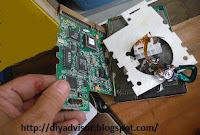 |
| Drill Hole in the Warning |
Tools and Supplies:
Bench or Flat Surface
Clamp 4-foot
Douglas Fir 2x4x4 (8)
Hammers Claw
Saw Horses (2)
Sledge Heavy
Now is the time to rid ourselves of old computer hard drives.
This post shows the four steps of removing destroying the ram information and memory chips in the hard drive circuit boards.
The primary purpose of damaging these circuit chips is to stop any potential information that might be used against you. Some circuits chips according to Wikipedia, the free encyclopedia" store configuration data, these circuitry chip can high has a high durability and ability to withstand high pressure, temperature and water immersion. But not a direct hit from a metal sledge hammer.
| 1 |
| This is the circuit board with intact memory chips from a hard drive. |
| 2 |
| This circuit board shows the parts, which include the board, the soft tissue, and the hard drive case. |
| 3 |
| This shows the circuit board memory chip for the hard drive had been destroyed using a claw hammer. |
| 4 |
|
This shows that all the memory chips were damaged using a metal sledge hammer. Top right, the warning sign is a preview of the last post dealing with the Etching and Drilling the hard drive disks. |
How To Destroy your Computer Information:
- Part 1 of 7 - Use Software First
- Part 2 of 7 - Removing Desktop Computer Hard Drive
- Part 3 of 7 - Tools
- Part 4 of 7 - Opening and Removing the Disk
- Part 5 of 7 - Hammering the Disk
- Part 6 of 7 - Ram and Solid State Drives
- Part 7 of 7 - Etching and Drilling
Update: DIY Advisor has New blogs check them today:
- Handyman Blog: DIY Advisor
- DIY Advisor Sitemap
- Food Blog: From Kiwis To Pistachios
- Food Blog Sitemap
- Tool Blog: DIY Advisor Toolbox
- Tool Blog Sitemap
- Artwork Blog: Light in Dark Artwork
- Artwork Blog Sitemap
- Class-A Tests: DIY Class-A Drivers License Tests
- Class-A Tests Sitemap: Class-A Sitemap
- DIY Poem: DIY Poem Meter Blog
- DIY Poem Sitemap: DIY Poem Sitemap
- Cookie Alert: European Union laws requires that you know that this blog uses cookies. If you are concerned about this please click here to see how Google uses this information.
Note: The DIY Advisor assumes no liability for omissions, errors or the outcome of any jobs. The reader must always exercise reasonable caution, follow current codes and regulations that may apply, and is urged to consult with a licensed contractor if in doubt about any steps on these posts. All names were changed to protect client's privacy. DIY Advisor. Reproduction of site content including photos without permission prohibited. All rights reserved. © Copyright 2011-





No comments:
Post a Comment